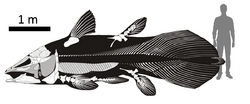Biology:Mawsoniidae
| Mawsoniids | |
|---|---|

| |
| Skeleton of a very large specimen of Mawsonia compared to a human | |
| Scientific classification | |
| Domain: | Eukaryota |
| Kingdom: | Animalia |
| Phylum: | Chordata |
| Clade: | Sarcopterygii |
| Class: | Actinistia |
| Order: | Coelacanthiformes |
| Suborder: | Latimerioidei |
| Family: | †Mawsoniidae Schultze 1993 |
| Genera | |
| |
Mawsoniidae is an extinct family of prehistoric coelacanth fishes which lived during the Triassic to Cretaceous periods. Members of the family are distinguished from their sister group, the Latimeriidae (which contains the living coelacanths of the genus Latimeria) by the presence of ossified ribs, a coarse rugose texture on the dermatocranium and cheek bones, the absence of the suboperculum and the spiracular, and reduction or loss of the descending process of the supratemporal. Mawsoniids are known from North America, Europe, South America, Africa, Madagascar and Asia. Unlike Latimeriidae, which are exclusively marine, Mawsoniidae were also native to freshwater and brackish environments.[1] Mawsoniids represent among the youngest known coelacanths, with the youngest known remains of the freshwater genus Axelrodichthys from France and an indeterminate marine species from Morocco being from the final stage of the Cretaceous, the Maastrichtian, roughly equivalent in age to the youngest known fossils of latimeriids.[2][3] Species of Mawsonia and Trachymetopon are known to have exceeded 5 metres in length, making them among the largest known bony fish to have ever existed.[4]
Phylogeny
The following cladogram is after Torino, Soto and Perea, 2021.[5]
| ||||||||||||||||||||||||||||||||||
| ||||||||||||||||||||||||||||||||||
References
- ↑ Cavin, Lionel; Cupello, Camila; Yabumoto, Yoshitaka; Léo, Fragoso; Deersi, Uthumporn; Brito, Paul M. (2019). "Phylogeny and evolutionary history of mawsoniid coelacanths". Bulletin of the Kitakyushu Museum of Natural History and Human History, Series A 17: 3–13. http://www.kmnh.jp/wp-content/uploads/2019/05/A17-3-Cavin.pdf.
- ↑ Cavin, Lionel; Buffetaut, Eric; Dutour, Yves; Garcia, Géraldine; Le Loeuff, Jean; Méchin, Annie; Méchin, Patrick; Tong, Haiyan et al. (2020-06-05). Carnevale, Giorgio. ed. "The last known freshwater coelacanths: New Late Cretaceous mawsoniid remains (Osteichthyes: Actinistia) from Southern France" (in en). PLOS ONE 15 (6): e0234183. doi:10.1371/journal.pone.0234183. ISSN 1932-6203. PMID 32502171. Bibcode: 2020PLoSO..1534183C.
- ↑ Brito, Paulo M.; Martill, David M.; Eaves, Ian; Smith, Roy E.; Cooper, Samuel L.A. (June 2021). "A marine Late Cretaceous (Maastrichtian) coelacanth from North Africa" (in en). Cretaceous Research 122: 104768. doi:10.1016/j.cretres.2021.104768. ISSN 0195-6671. Bibcode: 2021CrRes.12204768B. https://linkinghub.elsevier.com/retrieve/pii/S019566712100015X.
- ↑ Cavin, Lionel; Piuz, André; Ferrante, Christophe; Guinot, Guillaume (2021-06-03). "Giant Mesozoic coelacanths (Osteichthyes, Actinistia) reveal high body size disparity decoupled from taxic diversity" (in en). Scientific Reports 11 (1): 11812. doi:10.1038/s41598-021-90962-5. ISSN 2045-2322. PMID 34083600. Bibcode: 2021NatSR..1111812C.
- ↑ Toriño, Pablo; Soto, Matías; Perea, Daniel (2021-02-25). "A comprehensive phylogenetic analysis of coelacanth fishes (Sarcopterygii, Actinistia) with comments on the composition of the Mawsoniidae and Latimeriidae: evaluating old and new methodological challenges and constraints". Historical Biology 33 (12): 3423–3443. doi:10.1080/08912963.2020.1867982. ISSN 0891-2963. https://doi.org/10.1080/08912963.2020.1867982.
Wikidata ☰ Q1911997 entry
 |

